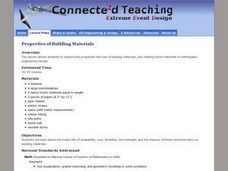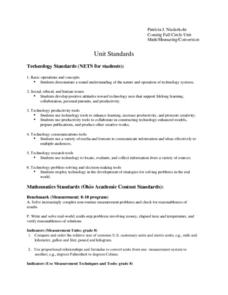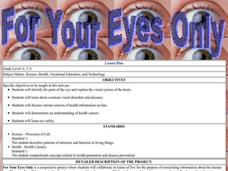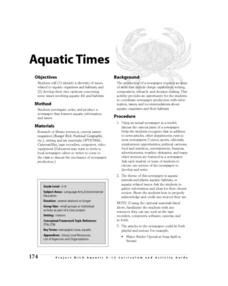Curated OER
DNA Fingerprinting: You Be the Judge!
Students use their knowledge of DNA fingerprinting to evaluate the use fingerprints in courts, and will address the ethics of establishing a national database of fingerprints.
Curated OER
Behind the Scenes -- Closing the Curtain on Stereotypes
Middle schoolers examine stereotypes in their community. They discuss the implications of having stereotypes and being prejudice against a group of people. They use a five step process in which to create another outcome to an experience...
Curated OER
DNA Fingerprinting: You Be the Judge!
Students explore DNA fingerprinting. Students discover how DNA fingerprinting is done and judge the validity. They evaluate the use of certain prints in courts and address the ethics of establishing a national database of fingerprpints.
Curated OER
Water and Ice
Young scholars study the water cycle and states of matter. In this water cycle lesson, students observe ice for a period of time and record their observations. Young scholars create a Venn Diagram comparing water in solid form and liquid...
Curated OER
Invest In Yourself
Students learn about budgeting, saving, dept, financial management, opportunity cost, and self-regulation. In this financial management lesson, students apply their knowledge of finance components and create their own web based plan...
Curated OER
The Business of Interest
Learners learn about finance and money management and use math to solve problems, communicate, and explore real life situations as they deal with banks. In this financial management lesson, students apply their math skills to real life...
Curated OER
Layers of the Earth: Plate Tectonics
Sixth graders participate in a lesson that is about investigating the different layers of the earth and defining how the plates move over the mantle. They engage in a variety of activities and use mathematics to create projects to...
Council for Economic Education
NOT Your Grandma's Lemonade Stand
Students participate in a WebQuest to apply economic concepts. In this economics lesson plan, students are guided to various websites and simulate being an entrepreneur.
Curated OER
Properties Of Building Materials
High schoolers investigate the concept of building materials and how they are used to create different things. They focus upon the availability, cost, flexibility, and strength of different building materials. This is done by taking part...
Curated OER
Eruption!
Students role-play as villagers, the governor, volcanologists, or the press in a simulation about the possible threat of a nearby volcanic eruption.
Curated OER
Getting to Know the Kwakiutl Indians
Third graders identify who the Kwakiutl Indians were and where they lived. They describe the way of life of the Kwakiutl and identify the natural resources used by the Kwakiutl, and describe the Kwakiutl's beliefs about nature.
Curated OER
Concern + Action = Clean Air Solutions
Students participate in a service project about improving air quality. In this air quality lesson, students understand the problems and solutions for improvement of air quality issues. Students discuss and choose an air quality service...
Curated OER
It's Rainin', It's Pouring
Students take a quick examine part of the water cycle, and the combined gas laws. The lesson lead them through the conditions necessary for cloud formation and allow them to create clouds in three different hands-on activities.
Curated OER
Personal Learning Profile Project
Students take notes on a prepared advanced organizer. They analyze dreams and goals across many parts of life and create different types (paths) of goals to accomplish dreams. They classify dreams and goals generated across these ...
Curated OER
Castle/Fort Unit
Students compare and contrast castles and forts. They observe buildings in their community and consider how castles and forts are similar. They design their own castle or fort and brainstorm materials to build with, discuss how the...
Curated OER
Science Workshops
Based on the popular Writer's Workshops used in language arts, Science Workshops can be used to teach both science content and process.
Curated OER
Angles That Pair
Students identify angles. In this angles that pair lesson, students identify adjacent, vertical, complementary, and supplementary angles. They use straws, pretzel sticks to demonstrate given types of angles.
Curated OER
Fast Food Survey Using Bar Graphs
Second graders create a bar graph to pictorically represent the data collected from a survey of students. They use Excel to electronically create the graphs and data tallies. They then interpret their data using sentences to explain.
Curated OER
Yellowstone Fires
Students assume the role of environmental biologists and help several government agencies resolve the debate surrounding "let it burn" policies in national parks.
Curated OER
Metric Olympics
Students participate in a Metric Olympics event and use metric measurements to measure actual performances in their events. They throw a plastic straw for a javelin event, participate in a long jump and high jump event, and a variety of...
Curated OER
For Your Eyes Only
Students complete several activities in a unit related to the eye. In this eye activity, students work in groups to research information about the human eye and create a multimedia presentation. They research anatomy of the eye, how the...
Curated OER
Aquatic Times
Learners identify a diversity of issues related to aquatic organisms and habitats and develop their own opinions concerning some issues involving aquatic life and habitats. They investigate, write and produce a newspaper that features...
Curated OER
Ancient Roman Monuments and Timeline
While a terrific idea, this lesson in which learners create a timeline showing the date that a variety of buildings and monuments were built in Ancient Rome, requires resources teachers may not have. It requires the use of a Smartboard,...
Curated OER
I Wonder How the Manduca Life Cycle Compares To the Human Life Cycle...
Students study life cycles including developing their understanding of the human life cycle. They decide where they are in the human life cycle and provide reasons for that placement. They compare the human life cycle to that of the...























